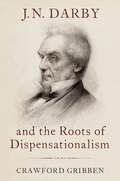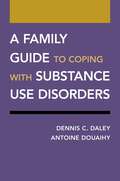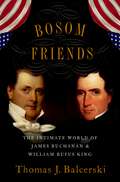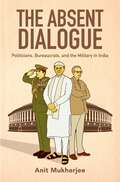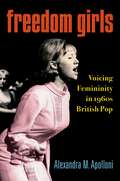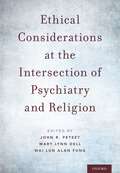- Table View
- List View
Enhancing Treatment Benefits with Exercise - TG: Component Interventions for Mood, Anxiety, Cognition, and Resilience (Treatments That Work)
by Michael W. Otto Jasper A. SmitsExercise has powerful effects on mental health. This therapist guide, and the accompanying workbook, provide an indispensable resource for practitioners who wish to expand their therapeutic range to include exercise-based interventions. A wealth of data shows the efficacy of these interventions for the treatment of mood and anxiety disorders, cognitive enhancement, and resilience training, including resilience training applied to the control of habit disorders like smoking. This therapist guide provides a step-by-step accounting of the benefits of exercise, the application of exercise to specific conditions, recommended exercise dose and durations, and, perhaps most importantly, motivational strategies to help clients get to and succeed with exercise. Fully revised and updated to capture the latest research in the area, this new edition also expands the content of the first edition to cover exercise for cognition, resilience, and smoking. Introductory chapters provide general guidance on strategies for initiating and maintaining exercise and are complemented by chapters devoted to the specific application of exercise to mood disorders, anxiety disorders, the enhancement of cognition, and for general resilience as might be applied in a relapse-prevention phase of treatment.
China's Economy: What Everyone Needs to Know? (What Everyone Needs to Know)
by Arthur R. KroeberChina's economic growth has been revolutionary, and is the foundation of its increasingly prominent role in world affairs. It is the world's second biggest economy, the largest manufacturing and trading nation, the consumer of half the world's steel and coal, the biggest source of international tourists, and one of the most influential investors in developing countries from southeast Asia to Africa to Latin America. Multinational companies make billions of dollars in profits in China each year, while traders around the world shudder at every gyration of the country's unruly stock markets. Perhaps paradoxically, its capitalist economy is governed by an authoritarian Communist Party that shows no sign of loosening its grip. China is frequently in the news, whether because of trade disputes, the challenges of its Belt and Road initiative for global infrastructure, or its increasing military strength. China's political and technological challenges, created by a country whose political system and values differ dramatically from most of the other major world economies, creates uncertainty and even fear. China's Economy: What Everyone Needs to Know? is a concise introduction to the most astonishing economic and political story of the last three decades. Arthur Kroeber enhances our understanding of China's changes and their implications. Among the essential questions he answers are: How did China grow so fast for so long? Can it keep growing and still solve its problems of environmental damage, fast-rising debt and rampant corruption? How long can its vibrant economy co-exist with the repressive one-party state? How do China's changes affect the rest of the world? This thoroughly revised and updated second edition includes a comprehensive discussion of the origins and development of the US-China strategic rivalry, including Trump's trade war and the race for technological supremacy. It also explores the recent changes in China's political system, reflecting Xi Jinping's emergence as the most powerful leader since Mao Zedong. It includes insights on changes in China's financial sector, covering the rise and fall of the shadow banking sector, and China's increasing integration with global financial markets. And it covers China's rapid technological development and the rise of its global Internet champions such as Alibaba and Tencent.
Sanctuary Cities: The Politics of Refuge
by Benjamin Gonzalez O'Brien Loren CollingwoodThe accidental shooting of Kathryn Steinle in July of 2015 by an undocumented immigrant ignited a firestorm of controversy around sanctuary cities, which are municipalities where officials are prohibited from inquiring into the immigration status of residents. Some decline immigration detainer requests from U.S. Immigration and Customs Enforcement. While sanctuary cities have been in existence since the 1980s, the Steinle shooting and the presidency of Donald Trump have brought them renewed attention and raised a number of questions. How have these policies evolved since the 1980s and how has the media framed them? Do sanctuary policies "breed crime" as some have argued, or do they help to politically incorporate immigrant populations? What do Americans think about sanctuary cities, and have their attitudes changed in recent years? How are states addressing the conflict between sanctuary cities and the federal government? In one of the first comprehensive examinations of sanctuary cities, Loren Collingwood and Benjamin Gonzalez O'Brien show that sanctuary policies have no discernible effect on crime rates; rather, anti-sanctuary state laws may undercut communities' trust in law enforcement. Indeed, sanctuary policies do have the potential to better incorporate immigrant populations into the larger city, with both Latino police force representation and Latino voter turnout increasing as a result. Despite this, public opinion on sanctuary cities remains sharply divided and has become intensely partisanized. Looking at public opinion data, media coverage, and the evolution of sanctuary policies from the 1980s to 2010s, the authors show that conservatives have increasingly drawn on anecdotal evidence to link violent crime to the larger debate about undocumented immigration. This has, in turn, provided them an electoral advantage among conservative voters who often see undocumented immigrants as a threat and has led to a push for anti-sanctuary policies in conservative states that effectively preempt local initiatives aimed at immigrant incorporation. Ultimately, this book finds that sanctuary cities provide important protection for immigrants, helping them to become part of the social and political fabric of the United States, with no empirical support for the negative consequences conservatives and anti-immigrant activists so often claim.
Capital Bluegrass: Hillbilly Music Meets Washington, DC (American Musicspheres)
by Kip LornellWith its rich but underappreciated musical heritage, Washington, D.C. is often overlooked as a cradle for punk, the birthplace of go go, and as the urban center for bluegrass in the Untied States. Capital Bluegrass: Hillbilly Music Meets Washington, D.C. richly documents the history and development of bluegrass in and around the nation's capital since it emerged in the 1950s. In his seventeenth book, American vernacular music scholar Kip Lornell discusses both well-known progressive bluegrass bands including the Country Gentlemen and the Seldom Scene, and lesser known groups like the Happy Melody Boys, Benny and Vallie Cain and the Country Clan, and Foggy Bottom. Lornell focuses on colorful figures such as the brilliant and eccentric mandolin player, Buzz Busby, and Connie B. Gay, who helped found the Country Music Association in Nashville. Moving beyond the musicians to the institutions that were central to the development of the genre, Lornell brings the reader into the nationally recognized Birchmere Music Hall, and tunes in to NPR powerhouse WAMU-FM, which for five decades broadcast as much as 40 hours a week of bluegrass programming. Dozens of images illuminate the story of bluegrass in the D.C. area, photographs and flyers that will be new to even the most veteran bluegrass enthusiast. Bringing to life a music and musical community integral to the history of the city itself, Capital Bluegrass tells an essential tale of bluegrass in the United States.
J.N. Darby and the Roots of Dispensationalism
by Crawford GribbenJ.N. Darby and the Roots of Dispensationalism describes the work of one of the most important and under-studied theologians in the history of Christianity. In the late 1820s, John Nelson Darby abandoned his career as a priest in the Church of Ireland to become one of the principal leaders of a small but rapidly growing religious movement that became known as the ?Plymouth Brethren.? Darby and other brethren modified the Calvinism that was common among their evangelical contemporaries, developing distinctive positions on key doctrines relating to salvation, the church, the work of the Holy Spirit, and the end times. After his death in 1882, Darby's successors revised and expanded his arguments, and Darby became known as the architect of the most influential system of end-times thinking among the world's half-a-billion evangelicals. This ?dispensational premillennialism? exercises extraordinary influence in religious communities, but also in popular culture and geopolitics. But claims that Darby created this theological system may need to be qualified -for all his innovation, this reputation might be undeserved. This book reconstructs Darby's theological development and argues that his innovations were more complex and extensive than their reduction into dispensationalism might suggest. In fact, Darby's thought might be closer to that of his Reformed critics than to that of modern exponents of dispensationalism.
J.N. Darby and the Roots of Dispensationalism
by Crawford GribbenJ.N. Darby and the Roots of Dispensationalism describes the work of one of the most important and under-studied theologians in the history of Christianity. In the late 1820s, John Nelson Darby abandoned his career as a priest in the Church of Ireland to become one of the principal leaders of a small but rapidly growing religious movement that became known as the ?Plymouth Brethren.? Darby and other brethren modified the Calvinism that was common among their evangelical contemporaries, developing distinctive positions on key doctrines relating to salvation, the church, the work of the Holy Spirit, and the end times. After his death in 1882, Darby's successors revised and expanded his arguments, and Darby became known as the architect of the most influential system of end-times thinking among the world's half-a-billion evangelicals. This ?dispensational premillennialism? exercises extraordinary influence in religious communities, but also in popular culture and geopolitics. But claims that Darby created this theological system may need to be qualified -for all his innovation, this reputation might be undeserved. This book reconstructs Darby's theological development and argues that his innovations were more complex and extensive than their reduction into dispensationalism might suggest. In fact, Darby's thought might be closer to that of his Reformed critics than to that of modern exponents of dispensationalism.
Shallow Equality and Symbolic Jurisprudence in Multilingual Legal Orders (Oxford Studies in Language and Law)
by Janny H.C. LeungWhat challenges face jurisdictions that attempt to conduct law in two or more languages? How does choosing a legal language affect the way in which justice is delivered? Answers to these questions are vital for the 75 officially bilingual and multilingual states of the world, as well as for other states contemplating a move towards multilingualism. Arguably such questions have implications for all countries in a world characterized by the pressures of globalization, economic integration, population mobility, decolonization, and linguistic re-colonization. For lawyers, addressing such challenges is made essential by the increased frequency and scale of transnational legal dealings and proceedings, as well as by the lengthening reach of international law. But it is not only policy makers, legislators, and other legal practitioners who must think about such questions. The relationship between societal multilingualism and law also raises questions for the burgeoning field of language and law, which posits--among other tenets--the centrality of language in legal processes. In this book, Janny H.C. Leung examines key aspects of legal multilingualism. Drawing extensively on case studies, she describes the implications of the legal, practical, and ideological dilemmas encountered in a given country when it becomes bilingual or multilingual, discussing such issues as: how legal certainty and the linguistic ideology of authenticity may be challenged in a multilingual jurisdiction; how courts balance the language preferences of different courtroom participants; and what historical, socio-political and economic factors may influence the decision to cement a given language as a jurisdiction's official language. Throughout, Leung elaborates a theory of "symbolic jurisprudence" to explore common dilemmas found across countries, despite their varied political and cultural settings, and argues that linguistic equality as proclaimed and practiced today is a shallow kind of equality. Although officially multilingual jurisdictions appear to be more inclusive than their monolingual counterparts, they run the risk of disguising substantive inequalities and displacing real efforts for more progressive social change. This is the first book to offer overarching discussion of how such issues relate to each other, and the first systematic study of legal multilingualism as a global phenomenon.
A Family Guide to Coping with Substance Use Disorders (Treatments That Work)
by Dennis C. Daley Antoine DouaihyThe potentially devastating impact of substance use disorders (SUDs) on family and concerned significant others has been well-documented, but there is hope. Loved ones can learn strategies to help them cope with the impact of SUDs, and these strategies will in turn help them to support recovery efforts. Family-friendly and accessible, A Family Guide to Coping with Substance Use Disorders provides readers with important information on substance use, symptoms, causes, effects, and treatment. Written by experts in the field of addiction medicine, this book enables readers to understand substance use disorders from the perspective of their affected loved one, and provides a positive perspective emphasizing that recovery is certainly possible. Using real-world examples, the book illustrates how SUDs can impact family units and family members, including children, and then provides practical strategies for supporting a loved one with a SUD and for addressing its impact on readers' own thoughts, behaviors, and emotional states. Helpful resources and links are provided, enabling readers to gain access to information and organizations that support families in recovery.
The Global Community Yearbook of International Law and Jurisprudence 2017 (Global Community: Yearbook of International Law & Jurisprudence)
by Giuliana Ziccardi CapaldoThe Global Community Yearbook is a one-stop resource for all researchers studying international law generally or international tribunals specifically. The Yearbook has established itself as an authoritative source of reference on global legal issues and international jurisprudence. It includes analysis of the most significant global trends in a way that allows readers to monitor the development of the global legal order from several perspectives. The Global Community Yearbook publishes annually in a volume of carefully chosen primary source material and corresponding expert commentary. The general editor, Professor Giuliana Ziccardi Capaldo, employs her vast expertise in international law to select excerpts from important court opinions and to choose experts from around the world to contribute essay-guides, which illuminate those cases. Although the main focus is recent case law from the major international tribunals and regional courts, the first four parts of each year's edition features expert articles by renowned scholars who address broader themes in current and future developments in international law and global policy, themes that appear throughout the case law of the many courts covered by the series as a whole. The Global Community Yearbook has thus become not just an indispensable window to recent jurisprudence: the series now also serves to prepare researchers for the issues facing emerging global law. The 2017 edition of The Global Community Yearbook both updates readers on the important work of long-standing international tribunals and introduces readers to more novel topics in international law. The Yearbook has established itself as an authoritative resource for research and guidance on the jurisprudence of both UN-based tribunals and regional courts. The 2017 edition continues to provide expert coverage of the Court of Justice of the European Union and diverse tribunals from the International Court of Justice (ICJ) to criminal tribunals such as the International Criminal Court (ICC) and the Tribunals for the Former Yugoslavia and Rwanda, to economically based tribunals such as ICSID and the WTO Dispute Resolution panel. This edition contains original research articles on the development and analysis of the concept of global law and the views of the global law theorists. It also includes expert introductory essays by prominent scholars in the realm of international law, on topics as diverse and current as the erosion of the postwar liberal global order by national populism and the accompanying disorder in global politics, a bifurcated global nuclear order due to the Nuclear Non-proliferation Treaty and the Nuclear Weapons Prohibition Treaty, and the expansion of the principle of no-impunity and its application to serious violations of social and economic rights. New to the 2017 edition, the author of the article in Recent Lines of International Thought will now talk about their own work as a Scholar/Judge. In addition, this edition memorializes the late M. Cherif Baasiouni. The Yearbook provides students, scholars, and practitioners alike a valuable combination of expert discussion and direct quotes from the court opinions to which that discussion relates, as well as an annual overview of the process of cross-fertilization between international courts and tribunals and a section focusing on the thought of leading international law scholars on the subject of the globalization. This publication can also be purchased on a standing order basis.
Preoperative Optimization of the Chronic Pain Patient: Enhanced Recovery Before Surgery
by Heath B. McAnally Lynda Welton Freeman Beth DarnallThe literature increasingly supports the position that elective surgery on poorly prepared chronic pain patients is not smart and ultimately in no-one's best interest. Just as patients with ischemic heart disease, obstructive lung disease, or diabetes can and need to be optimized prior to surgery, so too should chronic pain patients. The complex dynamics of chronic pain require a priori intervention - targeting enhanced recovery before surgery. Preoperative Optimization of the Chronic Pain Patient is a groundbreaking collaborative effort written by medical and psychological experts in the field of pain management with a specific interest in the perioperative arena. The modern emphasis on biopsychosocial-spiritual care is as important here as anywhere in medicine as comprehensive mind-body preparation is essential to optimize outcomes. That preparation entails replacing toxic thoughts (e.g., anxiety and pain catastrophizing) and behaviors (e.g., tobacco and opioid dependence; poor sleep, nutrition and exercise patterns) with beneficial ones. Such replacement of maladaptive cognitive-behavioral patterns requires the enhancement of patients' motivation and the cultivation of healthy habits. This book provides the framework for an evidence-based synthesis of counseling and intervention for preoperative optimization of chronic pain patients. Clinicians will learn to improve health and economic outcomes affecting their patient, health care team, and institution; to identify and target relevant issues, utilizing a holistic yet focused approach to optimization; and to collaborate with the patient and requisite multidisciplinary care team in a streamlined, efficient, and effective manner.
Bosom Friends: The Intimate World of James Buchanan and William Rufus King
by Thomas J. BalcerskiThe friendship of the bachelor politicians James Buchanan (1791-1868) of Pennsylvania and William Rufus King (1786-1853) of Alabama has excited much speculation through the years. Why did neither marry? Might they have been gay? Or was their relationship a nineteenth-century version of the modern-day "bromance"? In Bosom Friends: The Intimate World of James Buchanan and William Rufus King, Thomas J. Balcerski explores the lives of these two politicians and discovers one of the most significant collaborations in American political history. He traces the parallels in the men's personal and professional lives before elected office, including their failed romantic courtships and the stories they told about them. Unlikely companions from the start, they lived together as congressional messmates in a Washington, DC, boardinghouse and became close confidantes. Around the nation's capital, the men were mocked for their effeminacy and perhaps their sexuality, and they were likened to Siamese twins. Over time, their intimate friendship blossomed into a significant cross-sectional political partnership. Balcerski examines Buchanan's and King's contributions to the Jacksonian political agenda, manifest destiny, and the increasingly divisive debates over slavery, while contesting interpretations that the men lacked political principles and deserved blame for the breakdown of the union. He closely narrates each man's rise to national prominence, as William Rufus King was elected vice-president in 1852 and James Buchanan the nation's fifteenth president in 1856, despite the political gossip that circulated about them. While exploring a same-sex relationship that powerfully shaped national events in the antebellum era, Bosom Friends demonstrates that intimate male friendships among politicians were--and continue to be--an important part of success in American politics.
The Oxford Handbook of Galen (Oxford Handbooks)
by P. N. Singer and Ralph M. RosenThe Oxford Handbook of Galen provides a comprehensive overview of the life, work, and legacy of Galen (129--c. 216 CE), arguably the most important medical figure of the Graeco-Roman world. It contains essays by thirty leading experts on Galen's life and background, his medical theories, his therapeutic and clinical practices, and his philosophical contributions in the areas of logic, epistemology, causation, scientific method, and ethics. The authors offer accessible, but thorough and detailed, analyses of all major areas of Galen's thought, considered in their original historical context, as well as of the most important pathways of the transmission of his texts and his intellectual legacy, from late antiquity to early modern times and from western Europe to Tibet and China.
The Oxford Handbook of Galen (Oxford Handbooks)
The Oxford Handbook of Galen provides a comprehensive overview of the life, work, and legacy of Galen (129--c. 216 CE), arguably the most important medical figure of the Graeco-Roman world. It contains essays by thirty leading experts on Galen's life and background, his medical theories, his therapeutic and clinical practices, and his philosophical contributions in the areas of logic, epistemology, causation, scientific method, and ethics. The authors offer accessible, but thorough and detailed, analyses of all major areas of Galen's thought, considered in their original historical context, as well as of the most important pathways of the transmission of his texts and his intellectual legacy, from late antiquity to early modern times and from western Europe to Tibet and China.
The Absent Dialogue: Politicians, Bureaucrats, and the Military in India (Modern South Asia)
by Anit MukherjeeCivilian control over the military is widely hailed as one of the major successes of India's democracy. Because it is so rare, especially among post-colonial states, this control is rightfully celebrated. But has this come at a cost? In The Absent Dialogue, Anit Mukherjee argues that the pattern of civil-military relations in India has hampered its military effectiveness. Diving deep into understanding the organization and internal processes within the Indian military, he explains how Indian politicians and bureaucrats have long been content with the formal and ritualistic exercise of civilian control, while the military continues to operate in institutional silos. Yet, there has been little substantive engagement between the two. To support this claim, Mukherjee closely examines the variables most closely associated with military effectiveness-weapons procurement, jointness (the ability of separate military services to operate together), officer education, promotion policies, and defense planning. Further, Mukherjee shows how India's pattern of civil-military relations-best characterized as an absent dialogue-adversely affects each of these processes. While the book focuses on India, it also highlights the importance of civilian expertise and institutional design in enhancing civilian control and military effectiveness in other democracies. Informed by more than a hundred and fifty interviews and recently available archival material, The Absent Dialogue sheds new light on India's military and will reshape our understanding of both the history and contemporary dynamics of civil-military relations and recurring problems therein.
Surviving Vietnam: Psychological Consequences of the War for US Veterans
by Nick Turse Bruce P. Dohrenwend Thomas J. Yager Melanie M. WallThe war in Vietnam is a watershed moment in United States history -- the first war lost by the U.S. despite its seemingly overwhelming military might. Surviving Vietnam focuses on the psychological consequences, especially posttraumatic stress disorder (PTSD), of service in such a war for U.S. veterans. The diagnosis of PTSD, termed following and significantly influenced by this war, stirred controversy. Much of the initial controversy centered on a major report in 1990 of what numerous critics regarded as unrealistically high rates of this disorder in U.S. veterans. Controversy continues about whether exposure to one or more potentially traumatic events is more significant to the development and persistence of PTSD than pre-exposure personal vulnerability factors, such as age, education and prior psychiatric disorder. This book describes attempts to resolve these controversies. Surviving Vietnam develops a unique blend of historical material, military records, clinical diagnoses of PTSD, and interviews with representative samples of veterans surveyed approximately a decade (the National Vietnam Veterans Readjustment Study) and nearly four decades (the National Vietnam Veterans Longitudinal Study) after the war's conclusion. The book begins with a history of the Vietnam war that provides context for the discussions of mental health thereafter, the outcomes of the severity of veterans' exposure to combat, their personal involvement in harm to civilians and prisoners, their race-ethnicity, and their military assignments. It discusses nurses' experiences in Vietnam and the psychological impact of veterans' chronic war-related PTSD on their families. Surviving Vietnam then examines factors affecting veterans' post-war readjustment, including the effects of changing public and veteran attitudes toward the war and the veterans' own appraisals of the impact of the war on their lives after the war. The authors conclude with a discussion of the policy implications of the research findings.
Power, Image, and Memory: Historical Subjects in Art
by Peter J. HollidayThose who write history determine its narrative, whether through written text or through the visual language of art and public monuments. Power, Image, and Memory examines a wide variety of artistic traditions, showing how art commemorating historical events can shape collective memory, and with it, the identities of social groups and nations. From the Mesopotamians to the present day, leaders and societies have used art to frame and memorialize important events. This account establishes a dialogue among traditions in a series of case studies, ranging from the reliefs at Ramses' temple at Abu Simbel and the ancient Greek "Alexander Mosaic" to the Heian Period Japanese scroll of the Night Attack on the Sanjo Palace, the Benin Bronzes, Diego Vel?zquez's Surrender at Breda, and Picasso's Guernica. Weaving together meticulous historic detail, theory, and visual analysis, this volume offers a complex picture of the power of art and memory, as well as of the life of these monuments and messages over time, distanced from their original cultures and context. With insights relevant to contemporary debates reexamining historic monuments, Power, Image, and Memory sheds new light on the power of art to shape social memory and identity.
Power, Image, and Memory: Historical Subjects in Art
by Peter J. HollidayThose who write history determine its narrative, whether through written text or through the visual language of art and public monuments. Power, Image, and Memory examines a wide variety of artistic traditions, showing how art commemorating historical events can shape collective memory, and with it, the identities of social groups and nations. From the Mesopotamians to the present day, leaders and societies have used art to frame and memorialize important events. This account establishes a dialogue among traditions in a series of case studies, ranging from the reliefs at Ramses' temple at Abu Simbel and the ancient Greek "Alexander Mosaic" to the Heian Period Japanese scroll of the Night Attack on the Sanjo Palace, the Benin Bronzes, Diego Vel?zquez's Surrender at Breda, and Picasso's Guernica. Weaving together meticulous historic detail, theory, and visual analysis, this volume offers a complex picture of the power of art and memory, as well as of the life of these monuments and messages over time, distanced from their original cultures and context. With insights relevant to contemporary debates reexamining historic monuments, Power, Image, and Memory sheds new light on the power of art to shape social memory and identity.
Defense of the Scientific Hypothesis: From Reproducibility Crisis to Big Data
by Bradley E. AlgerDefense of Scientific Hypothesis: From Reproducibility Crisis to Big Data sets out to explain and defend the scientific hypothesis. Alger's mission is to counteract the misinformation and misunderstanding about the hypothesis that even seasoned scientists have concerning its nature and place in modern science. Most biological scientists receive little or no formal training in scientific thinking. Further, the hypothesis is under attack by critics who claim that it is irrelevant to science. In order to appreciate and evaluate scientific controversies like global climate change, vaccine safety, etc., the public first needs to understand the hypothesis. Defense of Scientific Hypothesis begins by describing and analyzing the scientific hypothesis in depth and examining its relationships to various kinds of science. Alger then guides readers through a review of the hypothesis in the context of the Reproducibility Crisis and presents survey data on how scientists perceive and employ hypotheses. He assesses cognitive factors that influence our ability to use the hypothesis and makes practical and policy recommendations for teaching and learning about it. Finally, Alger considers two possible futures of the hypothesis in science as the Big Data revolution looms: in one scenario, the hypothesis is displaced by the Big Data Mindset that forgoes understanding in favor of correlation and prediction. In the other, robotic science incorporates the hypotheses into mechanized laboratories guided by artificial intelligence. But in his illuminating epilogue, Alger envisions a third way, the Centaur Scientist, a symbiotic relationship between human scientists and computers.
Freedom Girls: Voicing Femininity in 1960s British Pop
by Alexandra M. ApolloniFreedom Girls: Voicing Femininity in 1960s British Pop shows how the vocal performances of girl singers in 1960s Britain defined-and sometimes defied-ideas about what it meant to be a young woman in the 1960s British pop music scene. The singing and expressive voices of Sandie Shaw, Cilla Black, Millie Small, Dusty Springfield, Lulu, Marianne Faithfull, and P.P. Arnold, reveal how vocal sound shapes access to social mobility, and consequently, access to power and musical authority. The book examines how Sandie Shaw and Cilla Black's ordinary girl personas were tied to whiteness and, in Black's case, her Liverpool origins. It shows how Dusty Springfield and Jamaican singer Millie Small engaged with the transatlantic sounds of soul and and ska, respectively, transforming ideas about musical genre, race, and gender. It reveals how attitudes about sexuality and youth in rock culture shaped the vocal performances of Lulu and Marianne Faithfull, and how P.P. Arnold has re-narrated rock history to center Black women's vocality. Freedom Girls draws on a broad array of archival sources, including music magazines, fashion and entertainment magazines produced for young women, biographies and interviews, audience research reports, and others to inform analysis of musical recordings (including such songs as "As Tears Go By," "Son of a Preacher Man," and others) and performances on television programs such as Ready Steady Go!, Shindig, and other 1960s music shows. These performances reveal the historical and contemporary connections between voice, social mobility, and musical authority, and demonstrate how singers used voice to navigate the boundaries of race, class, and gender.
Henry Enfield Roscoe: The Campaigning Chemist
by Peter Reed Peter J.T. MorrisLittle known today, Henry Enfield Roscoe was one of the most prominent chemists and educational reformers in Victorian Britain. Having studied in Heidelberg, he worked to transform English education by using Germany as a model. He made Owens College, Manchester, viable and converted it into Victoria University (now the University of Manchester). He then campaigned for the reform of technical education in an alliance with like-minded campaigners which resulted in the Technical Instruction Act of 1889. Roscoe was also the Liberal MP for South Manchester between 1885 and 1895, one of the few academic chemists to become a member of the House of Commons. In his "retirement," he helped found the Lister Institute of Preventive Medicine. Yet, despite his extensive impact on Britain at the time and our society today, he remains largely forgotten. In this detailed biography, authors Morris and Reed provide a timely and original contribution to the history of nineteenth-century British science and its relation to education, industry, and government policy, highlighting Roscoe's significant contributions and legacy as one of the leading scientists of his generation.
Bulk Collection: Systematic Government Access to Private-Sector Data
by James X. Dempsey Fred H. CateThis is an open access title available under the terms of a CC BY-NC-ND 4.0 International licence. It is free to read at Oxford Scholarship Online and offered as a free PDF download from OUP and selected open access locations. This book is the culmination of nearly six years of research initiated by Fred Cate and Jim Dempsey to examine national practices and laws regarding systematic government access to personal information held by private-sector companies. Leading an effort sponsored by The Privacy Projects, they commissioned a series of country reports, asking national experts to uncover what they could about government demands on telecommunications providers and other private-sector companies to disclose bulk information about their customers. Their initial research found disturbing indications of systematic access in countries around the world. These data collection programs, often undertaken in the name of national security, were cloaked in secrecy and largely immune from oversight, posing serious threats to personal privacy. After the Snowden leaks confirmed these initial findings, the project morphed into something more ambitious: an effort to explore what should be the rules for government access to private-sector data, and how companies should respond to government demands for access. This book contains twelve updated country reports plus eleven analytic chapters that present descriptive and normative frameworks for assessing national surveillance laws, survey evolving international law and human rights principles applicable to government surveillance, and describe oversight mechanisms. It also explores the concept of accountability and the role of encryption in shaping the surveillance debate. Cate and Dempsey conclude by offering recommendations for both governments and industry.
Bulk Collection: Systematic Government Access to Private-Sector Data
This is an open access title available under the terms of a CC BY-NC-ND 4.0 International licence. It is free to read at Oxford Scholarship Online and offered as a free PDF download from OUP and selected open access locations. This book is the culmination of nearly six years of research initiated by Fred Cate and Jim Dempsey to examine national practices and laws regarding systematic government access to personal information held by private-sector companies. Leading an effort sponsored by The Privacy Projects, they commissioned a series of country reports, asking national experts to uncover what they could about government demands on telecommunications providers and other private-sector companies to disclose bulk information about their customers. Their initial research found disturbing indications of systematic access in countries around the world. These data collection programs, often undertaken in the name of national security, were cloaked in secrecy and largely immune from oversight, posing serious threats to personal privacy. After the Snowden leaks confirmed these initial findings, the project morphed into something more ambitious: an effort to explore what should be the rules for government access to private-sector data, and how companies should respond to government demands for access. This book contains twelve updated country reports plus eleven analytic chapters that present descriptive and normative frameworks for assessing national surveillance laws, survey evolving international law and human rights principles applicable to government surveillance, and describe oversight mechanisms. It also explores the concept of accountability and the role of encryption in shaping the surveillance debate. Cate and Dempsey conclude by offering recommendations for both governments and industry.
Ethical Considerations at the Intersection of Psychiatry and Religion
by John R. Peteet, Mary Lynn Dell and Wai Lun Alan FungPsychiatry and religion/spirituality (R/S) share an interest in human flourishing, a concern with beliefs and values, and an appreciation for community. Yet historical tensions between science and religion continue to impede dialogue, leaving clinicians uncertain about how to approach ethical questions arising between them. When are religious practices such as scrupulosity disordered? What distinguishes healthy from unhealthy religion? How should a therapist approach a patient's existential, moral or spiritual distress? What should clinicians do with patients' R/S convictions about faith healing, same-sex relationships, or obligations to others? Discussions of psychiatric ethics have traditionally emphasized widely accepted principles, generally admired virtues, and cultural competence. Relatively little attention has been devoted to the ways that R/S inform the values of patients and their clinicians, shape preferred virtues, and interact with culture. Ethical Considerations at the Intersection of Psychiatry and Religion aims to give mental health professionals a conceptual framework for understanding the role of R/S in ethical decision-making and serve as practical guidance for approaching challenging cases. Part I addresses general considerations, including the basis of therapeutic values in a pluralistic context, the nature of theological and psychiatric ethics, spiritual issues arising in diagnosis and treatment, unhealthy and harmful uses of religion, and practical implications of personal spirituality. Part II examines how these considerations apply in specific contexts: inpatient and outpatient, consultation-liaison, child and adolescent, geriatric, disability, forensic, community, international, addiction and disaster and emergency psychiatry, as well as in the work of religious professionals, ethics committees, psychiatric education, and research. Thick descriptions of case examples analyzed using the framework of Jonson and Winslow show the clinical relevance of understanding the contributions of religion and spirituality to patient preferences, quality of life, decision making, and effective treatment.
Clinical Pediatric Anesthesia: A Case-Based Handbook
by Erin S. Williams, Olutoyin A. Olutoye, Catherine P. Seipel And Titilopemi A. O. AinaThis second edition of Clinical Pediatric Anesthesia: A Case-Based Handbook offers a comprehensive review of the options, advantanges, and disadvantages of different aspects of the perioperative management of the pediatric patient, as well as examples of a wide range of relevant clinical scenarios. Chapters are organized into 15 sections and cover the field of pediatric anesthesiology with a point-of-care approach. Written by a team of over 50 Pediatric Anesthesiologists at tertiary children's hospitals, this highly accessible text provides readers with multiple approaches to the anesthetic care of the pediatric patient. Each chapter includes an introduction to the topic, followed by learning objectives, clinical vignettes, and a discussion section styled in a question-and-answer format, concluding with a summary of the highest-yield and most salient information. Chapters also provide annotated references and suggestions for further reading to facilitate in-depth study of topic. The variety of cases presented, along with the contributors' expertise, render valuable real-life clinical situations that promote critical thinking and evaluation necessary for all pediatric anesthesiology consultants.
The Global Community Yearbook of International Law and Jurisprudence 2015 (Global Community: Yearbook of International Law & Jurisprudence)
by Giuliana Ziccardi CapaldoThe Global Community Yearbook is a one-stop resource for all researchers studying international law generally or international tribunals specifically. The Yearbook has established itself as an authoritative source of reference on global legal issues and international jurisprudence. It includes analysis of the most significant global trends in a way that allows readers to monitor the development of the global legal order from several perspectives. The Global Community Yearbook publishes annually in a volume of carefully chosen primary source material and corresponding expert commentary. The general editor, Professor Giuliana Ziccardi Capaldo, employs her vast expertise in international law to select excerpts from important court opinions and to choose experts from around the world to contribute essay-guides, which illuminate those cases. Although the main focus is recent case law from the major international tribunals and regional courts, the first four parts of each year's edition features expert articles by renowned scholars who address broader themes in current and future developments in international law and global policy, themes that appear throughout the case law of the many courts covered by the series as a whole. The Global Community Yearbook has thus become not just an indispensable window to recent jurisprudence: the series now also serves to prepare researchers for the issues facing emerging global law. The 2015 edition of The Global Community Yearbook both updates readers on the important work of long-standing international tribunals and introduces readers to more novel topics in international law. The Yearbook has established itself as an authoritative resource for research and guidance on the jurisprudence of both U.N.-based tribunals and regional courts. The 2015 edition continues to provide expert coverage of the Court of Justice of the European Union, and diverse tribunals from the criminal tribunals for the Former Yugoslavia and Rwanda, to economically based tribunals such as ICSID and the WTO Dispute Resolution panel. This edition includes expert introductory essays by prominent scholars in the realm of international law, on topics as diverse and current as the fusion of eastern and western civil disobedience to the concept of jus cogens. Included in the 2015 edition, researchers will find detailed guidance on a rich diversity of legal topics, from the concept of universal jurisdiction over international crimes and the increased push for transparency in resolution of international economic disputes to the issue of religion and multiculturalism in Europe through a focus on Islam. This edition also provides students, scholars, and practitioners alike a valuable combination of expert discussion and direct quotes from the court opinions to which that discussion relates. This publication can also be purchased on a standing order basis.




